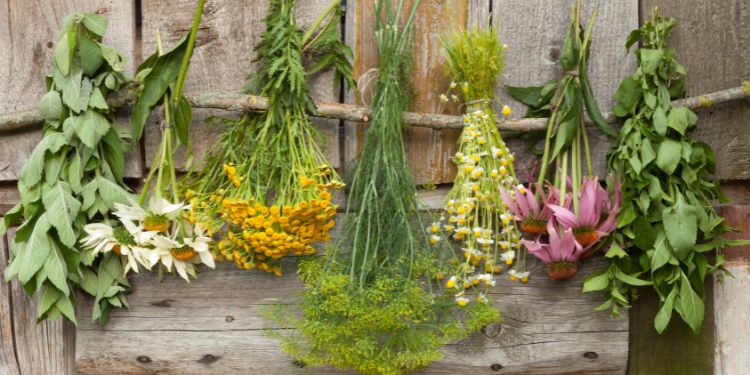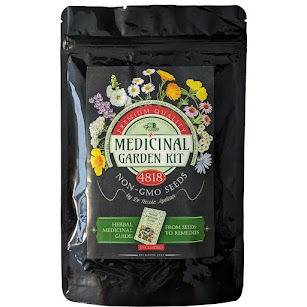
by KATHERINE PATERSON
Let’s be honest; convenience often drives our choices. We seek the easy route in all we do, and because of this, it’s easy to forget the healing power of nature.
Over-the-counter medicines have become a go-to solution for minor ailments, but did you know that many of these remedies have natural plant counterparts that you can easily grow in your own backyard? This could prove valuable should SHTF!
You do not need to be an expert green thumb to grow medicinal plants in your garden. A little knowledge, some determination, and a lot of patience go a long way.
Aloe Vera: Nature’s Skin Soother
Over-the-Counter Counterpart/Uses: Burn and wound creams.
Aloe vera is a well-known succulent prized for its skin-healing properties. Its gel-like substance contains vitamins, minerals, and amino acids that aid in soothing sunburns, cuts, and minor skin irritations. Plant it in well-draining soil in a sunny spot and water sparingly, allowing the soil to dry out between waterings.
Instructions:
- Choose a mature aloe vera leaf from your plant.
- Using a sharp knife, carefully slice the leaf lengthwise to expose the gel inside.
- Scoop out the gel using a spoon and transfer it to a clean container.
- Apply the aloe vera gel directly to sunburns, cuts, or irritated skin as needed for soothing relief.
Peppermint: A Digestive Dynamo
Over-the-Counter Counterpart/Uses: Digestive aids.
Peppermint is a fragrant herb renowned for alleviating digestive discomforts like indigestion and bloating.
Its natural oils contain menthol, which helps to ease and relax the muscles of the gastrointestinal tract. Plant peppermint in a partially shaded area with well-draining soil.
Related: Make Your Own Peppermint Oil – The Best Insect Repellent
Instructions:
- Boil water and let it cool slightly.
- Place a handful of fresh peppermint leaves or 1-2 teaspoons of dried peppermint leaves in a cup.
- Pour the hot water over the leaves.
- Cover the cup and let the leaves steep for 5-10 minutes.
- Remove the leaves and enjoy your soothing peppermint tea. You can sweeten it with honey if desired.
Chamomile: The Calming Elixir
Over-the-Counter Counterpart/Uses: Sleep aids and relaxants.
Chamomile is a gentle flowering herb known for its calming and sleep-inducing properties. Its delicate flowers are rich in antioxidants and essential oils that promote relaxation. Grow chamomile in well-draining soil under full sun to partial shade conditions. Regular deadheading encourages continuous blooms.
Instructions:
- Place a teaspoon of dried chamomile flowers or a few fresh ones in a cup.
- Pour hot water over the flowers.
- Cover the cup and let the flowers steep for 5-10 minutes.
- Strain and sip it before bedtime for a calming and relaxing sleep aid.
Lavender: Soothe Your Senses
Over-the-Counter Counterpart/Uses: Anxiety and stress relief aids.
Lavender is celebrated for its aromatic beauty and ability to reduce anxiety and stress. Its essential oils possess calming effects that can be harnessed through infusions and aromatherapy.
Plant lavender in well-drained soil with good air circulation. This sun-loving herb requires minimal water once established.
Instructions:
- Fill small cloth or sachet bags with dried lavender flowers.
- Tie the bags securely with a string or ribbon.
- Place the lavender sachets in your drawers, closets, or under your pillow to enjoy the calming aroma.
Echinacea: Immune-Boosting Powerhouse
Over-the-Counter Counterpart/Uses: Immune system support.
Echinacea, commonly known as purple coneflower, is a flowering plant cherished for its immune-boosting properties. Its roots, leaves, and flowers contain compounds that stimulate the immune system. Cultivate it in well-drained soil under full sun. Regular deadheading encourages prolonged flowering.
⇒ [TAG18]
Instructions:
- Chop fresh echinacea flowers and leaves finely.
- Fill a glass jar about halfway with the chopped plant material.
- Pour vodka or apple cider vinegar over the plant material, ensuring it’s completely covered.
- Seal the jar tightly and store it in a cool, dark place for 4-6 weeks, shaking it daily.
- Strain the tincture and transfer it to a dark glass bottle. Take a small amount daily to support your immune system.
Lemon Balm: The Mood Lifter
Over-the-Counter Counterpart/Uses: Stress and anxiety relief.
Lemon balm is a fragrant herb known for its mood-lifting effects and potential to reduce stress. Its leaves contain compounds that promote relaxation.
Plant lemon balm in rich, well-draining soil with partial shade. Regular pruning prevents the plant from becoming invasive.
Instructions:
- Place a handful of fresh lemon balm leaves or 1-2 teaspoons of dried leaves in a cup.
- Pour hot water over the leaves.
- Cover the cup and let the leaves steep for 5-10 minutes.
- Strain the tea and enjoy its soothing and uplifting effects.
Garlic: Nature’s Antibiotic
Over-the-Counter Counterpart/Uses: Antibacterial and antiviral agents.
Garlic is a culinary staple with impressive medicinal qualities. Its active compound, allicin, exhibits antibacterial and antiviral properties.
Plant garlic cloves in well-drained soil with good sunlight exposure. Harvest when the leaves turn yellow, and the bulbs have formed cloves.
Instructions:
- Peel and finely chop fresh garlic cloves.
- Place the chopped garlic in a clean, dry glass jar.
- Pour olive oil over the garlic until it’s fully covered.
- Seal the jar and let it sit in a cool, dark place for about 1-2 weeks.
- Strain the oil into a clean container using a fine mesh strainer or cheesecloth. Use the garlic-infused oil for cooking or as a topical remedy.
Calendula: Healing for the Skin
Over-the-Counter Counterpart/Uses: Topical creams and ointments.
Calendula, or marigold, is a vibrant flower renowned for its skin-healing properties. Its petals contain anti-inflammatory and antiseptic compounds that aid in wound healing.
Plant calendula in well-drained soil with good sunlight. Deadhead spent flowers to encourage continuous blooming.
Related: How To Make a Powerful Calendula Extract to Keep in Your Medicine Cabinet (with pictures)
Instructions:
- Infuse the carrier oil with dried calendula petals using the same method as the arnica oil recipe (see below).
- Strain the infused oil into a clean container.
- In a double boiler, melt a small amount of beeswax.
- Mix the melted beeswax with the infused calendula oil to create a salve consistency.
- Pour the mixture into small containers and let it cool and solidify.
- Apply the calendula salve to dry or irritated skin as needed for nourishing relief.
Arnica: Nature’s Pain Reliever
Over-the-Counter Counterpart/Uses: Pain relief creams and ointments.
Arnica is a flowering plant used for centuries to alleviate pain and reduce inflammation. Its active compounds, such as helenalin, possess analgesic properties, making it a popular choice for treating bruises, muscle aches, and joint pain. To grow it, choose a well-drained location with partial to full sunlight.
⇒ [TAG21]
Instructions:
- Gently rinse the fresh arnica flowers to remove any dirt or debris.
- Pat the flowers dry with a clean cloth or paper towel.
- Fill a clean, dry glass jar about halfway with the arnica flowers.
- Pour the carrier oil over the flowers until fully covered, ensuring at least an inch of oil above them.
- Seal the jar tightly and place it in a warm, sunny spot for about 4-6 weeks. Shake the jar gently every day.
- After the infusion, strain the oil through a fine mesh strainer or cheesecloth into a clean container.
- Store the arnica oil in a cool, dark place. Apply it topically to areas of pain and discomfort as needed.
Turmeric: Golden Elixir for Joint Pain
Over-the-Counter Counterpart/Uses: Anti-inflammatory supplements.
Turmeric is a vibrant yellow spice known for its potent anti-inflammatory properties, primarily attributed to its active compound, curcumin. This plant can be grown in warmer climates or pots indoors. Plant turmeric in well-draining soil and provide ample sunlight. Harvest the rhizomes when they are mature and vibrant in color.
Ingredients:
- 1 cup milk (dairy or plant-based)
- 1/2 teaspoon ground turmeric
- 1/4 teaspoon ground cinnamon
- 1/8 teaspoon ground ginger
- A pinch of black pepper (enhances curcumin absorption)
- Honey or sweetener of choice (optional)
Instructions:
- In a small saucepan, gently heat the milk over low-medium heat.
- Add the ground turmeric, cinnamon, ginger, and black pepper to the milk.
- Whisk the mixture continuously until it’s well combined and heated through. Be careful not to let it boil.
- Remove the saucepan from the heat and let the mixture cool slightly.
- If desired, sweeten the golden milk with honey or your preferred sweetener.
- Pour the golden milk into a mug and enjoy its soothing effects on inflammation and joint pain.
Incorporating these plants into your garden and daily routines allows you to embrace a more nature-centric approach to managing pain and side-stepping potential problems such as adverse side effects or addiction.
Nature’s pharmacy is vast, offering alternatives to conventional over-the-counter medicines with a touch of greenery and the satisfaction of nurturing life.

By cultivating these healing plants in your garden, you gain access to natural remedies and create a sanctuary of health and wellness right outside your door. The Pharmaceutical Industry almost made this knowledge obsolete. But in my opinion this knowledge should not be lost. We might need it when things go really bad. So please feel free to share or print this article and put it in your bug-out-bag or your SHTF survival kit. You ca also grow your medicinal garden. For this purpose we put together a Medicinal Garden Kit that will help you turn a backyard into a pharmacy. The kit contains ten powerful herbal seed packages( 2,409 high-quality seeds, GMO Free) that can help us provide relief from illness. Moreover, there is no need to worry about how to care for them as the product comes with a detailed instruction manual on how to use these medicinal plants.If you like to try you can get yours HERE !
The post OTC Meds In Your Backyard: 10 Plant Alternatives appeared first on Bio Prepper.
By: James Cole
Title: OTC Meds In Your Backyard: 10 Plant Alternatives
Sourced From: www.bioprepper.com/2024/02/14/otc-meds-in-your-backyard-10-plant-alternatives/
Published Date: Wed, 14 Feb 2024 14:23:49 +0000
------------------------
Did you miss our previous article...
https://bushcrafttips.com/bushcraft-news/how-to-get-an-emergency-supply-of-antibiotics
 What is BushcraftSurvival SkillsToolsVideosBushcraft CampsBushcraft KitsBushcraft ProjectsPrivacy PolicyTerms And Conditions
What is BushcraftSurvival SkillsToolsVideosBushcraft CampsBushcraft KitsBushcraft ProjectsPrivacy PolicyTerms And Conditions
